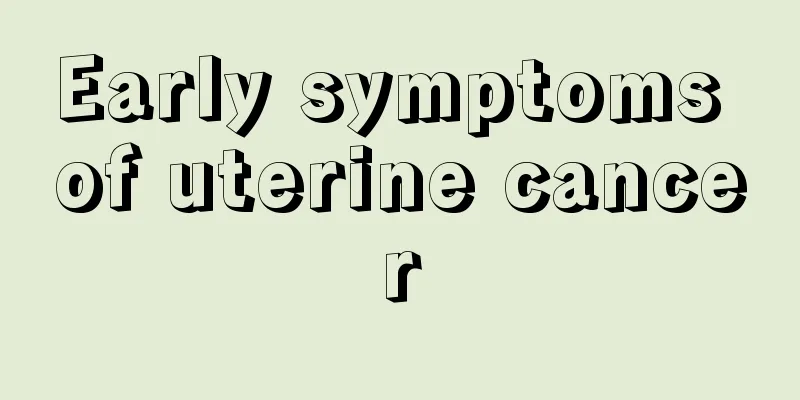How to treat ascites in liver cancer? There are 4 stages of ascites in liver cancer

|
Liver cancer is a disease that endangers many people in today's society. There are generally four stages of ascites in the late stage, and the symptoms of each stage are different. Do you know the four stages of ascites in liver cancer? Stage 1: Pre-ascites Liver cancer patients generally do not have much ascites in the early stage of ascites, but as the patient continues to receive fluid infusion, excessive sodium intake in the body can cause water and sodium retention. This period of time is a critical period of danger, when the kidneys have already been impaired in processing sodium. Reducing the amount of fluid input at this time can reverse the occurrence of ascites. Stage 2: Reactive ascites During this period, sodium and water retention increases significantly, causing total blood volume to expand, and then peripheral arteries to expand to reduce vascular resistance. At this time, visceral tissues can release a large amount of vasodilators, causing peripheral blood vessels to expand, which in turn drives the entire body circulation to expand, forming ascites. During this period, diuretics should be used appropriately to avoid causing water and electrolyte metabolism disorders in patients, which may lead to serious consequences. Stage 3: Refractory Ascites As liver cancer continues to progress and worsen, patients during this period experience obvious sodium and water retention, severe systemic edema, are insensitive to diuretic treatment, and do not experience significant improvement in ascites. Stage 4: Hepatorenal syndrome Hepatorenal syndrome stage This is the last and most serious stage of the development of ascites. This stage often occurs in patients with refractory ascites in the decompensated stage of liver cancer, especially those with cirrhosis. It is manifested by severe ascites, selective renal hypoperfusion, severe sodium and water retention, and renal failure. Coma may have occurred. So how to treat liver cancer when ascites occurs? 1. Draining ascites can quickly reduce intra-abdominal pressure, relieve the compression symptoms of the heart, lungs, kidneys and gastrointestinal tract, and relieve the patient's pain. However, this relief is only temporary. Ascites will grow rapidly in a short period of time. Repeated drainage of ascites will lead to a large loss of body fluids and proteins, water and electrolyte disorders, orthostatic hypotension, and induce hepatic coma and other serious consequences. Therefore, draining ascites cannot be the first choice of treatment. For individual patients, when ascites affects respiratory function and heart and kidney function, abdominal puncture and drainage of ascites can be considered to reduce intra-abdominal pressure, increase renal blood flow, and temporarily improve respiratory function and heart and kidney function. After draining ascites, the abdomen should be bandaged with pressure to prevent a sharp drop in intra-abdominal pressure and adverse reactions such as hypotension. The first drainage volume generally does not exceed 800 ml, and the subsequent drainage volume should be less than 500 ml each time, and appropriate albumin should be supplemented after draining ascites. 2. Reinfusion of ascites: If the ascites is not infected and no cancer cells are found, the ascites can be reinfused into the patient's body, which can not only relieve the patient's pain, but also prevent the loss of body fluid and protein, electrolyte disorder and hepatic coma caused by the large amount of ascites discharged; the ascites can also be reinfused after being dialyzed or concentrated by ultrafiltration, which can not only retain the body's protein, increase plasma osmotic pressure, and reduce the formation of ascites, but also increase the body's effective circulating blood volume, increase the glomerular filtration rate, block the activity of the renin-angiotensin-aldosterone system, inhibit the secretion of antidiuretic hormone, and maintain and correct the electrolyte balance in the body. It is better than simple ascites reinfusion. About 5000-10000ml of ascites can be extracted within 4-8 hours, and then reinfused after being concentrated to 500-1000ml by dialyzation or ultrafiltration. Generally, it is performed about 4 times within 2 weeks, and good results can often be achieved. It should be prohibited for patients with severe heart failure, coagulation disorders and recent gastrointestinal bleeding. 3. Intraperitoneal chemotherapy can appropriately discharge some ascites. Injecting anti-tumor drugs into the peritoneal cavity can reduce the formation of ascites in the body, increase the drug maintenance capacity of the liver and the peritoneal cavity, and the toxic reaction is much smaller than that of systemic use of the same drugs. 4. Diuretics can be used to increase the excretion of water and sodium. It is advisable to use multiple types alternately or in combination, and pay attention to the balance of electrolytes. In mild cases, potassium-excreting diuretics such as hydrochlorothiazide, chlorthalidone, and furosemide can be taken orally. 5. Limit water and sodium intake. It is currently advocated that patients with ascites do not need to completely prohibit sodium salt intake. For mild cases, the daily sodium intake should not exceed 1g, and for severe cases, it should not exceed 0.5g, and water intake should be appropriately limited. |
Recommend
How to recover after being injured by dishwashing liquid
In our daily life, detergent is indispensable. Wh...
Best tumor markers for ovarian cancer diagnosis
Currently, there are two methods for detecting CE...
How to relieve pain in patients with gastric cancer? There are four treatments
Gastric cancer pain is very unbearable, but it ca...
Is it better to eat sea cucumber or ganoderma lucidum for diabetes
In addition to following the doctor's advice ...
What are the symptoms of colon cancer
Colorectal cancer is a malignant tumor of the dig...
What are the seafoods? Eating them regularly will make you healthier
There are so many types of seafood, including fis...
How to reduce rectal prolapse
After suffering from hemorrhoids, it is easy to h...
What are the foods that nourish the kidneys for yin deficiency
Kidney Yin deficiency refers to the deficiency of...
What happens if you wear your contact lenses upside down
Although contact lenses can be more beautiful, we...
Can you eat things bitten by cockroaches?
Can you eat things bitten by cockroaches? Cockroa...
It's hard when I press near my belly button
Common sense tells us that problems with the body...
What are the nursing issues for endometrial cancer
When certain problems occur in the body, the body...
Is ablation not recommended for thyroid cancer?
Ablation surgery is not recommended for thyroid c...
Symptoms of chronic gastroenteritis, these manifestations are the most common
The most common symptoms of chronic gastritis are...
How to make dishes more fragrant, little tips to help you
Food is the first necessity of people. Eating is ...









